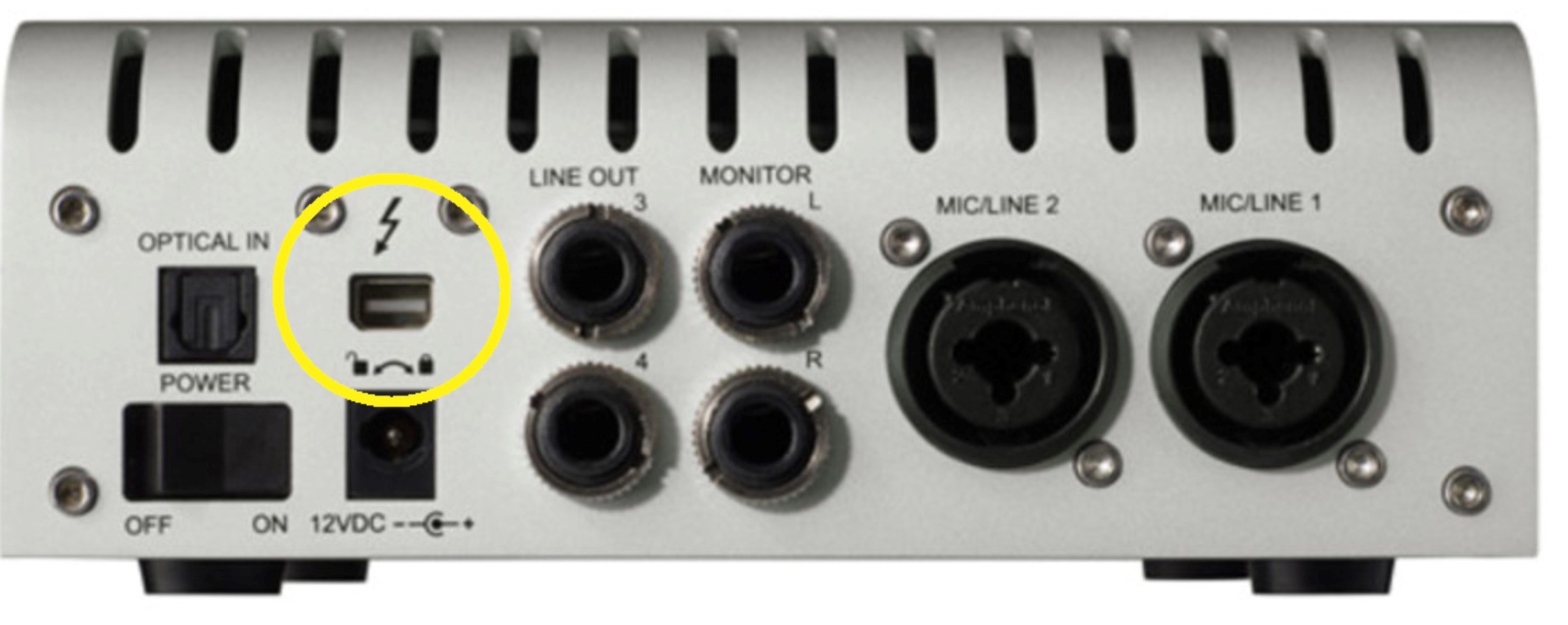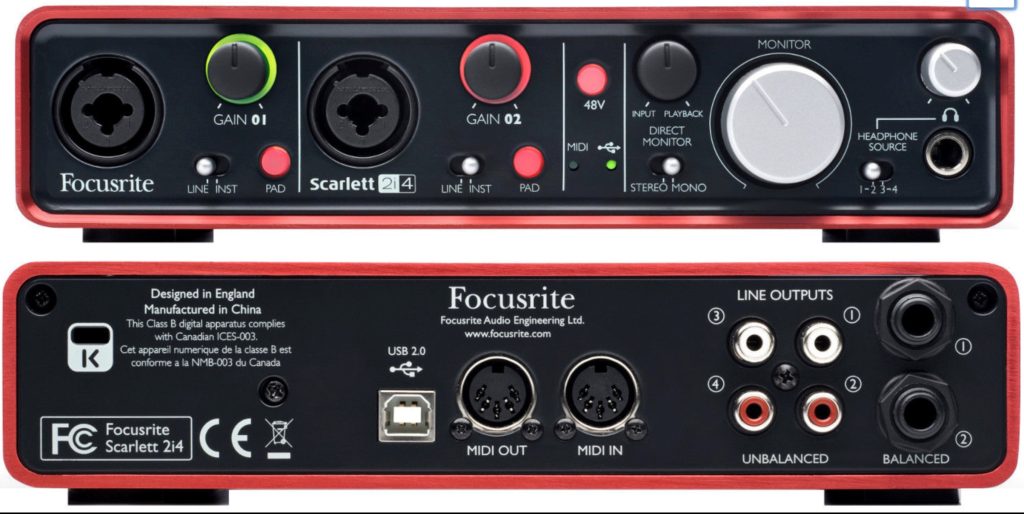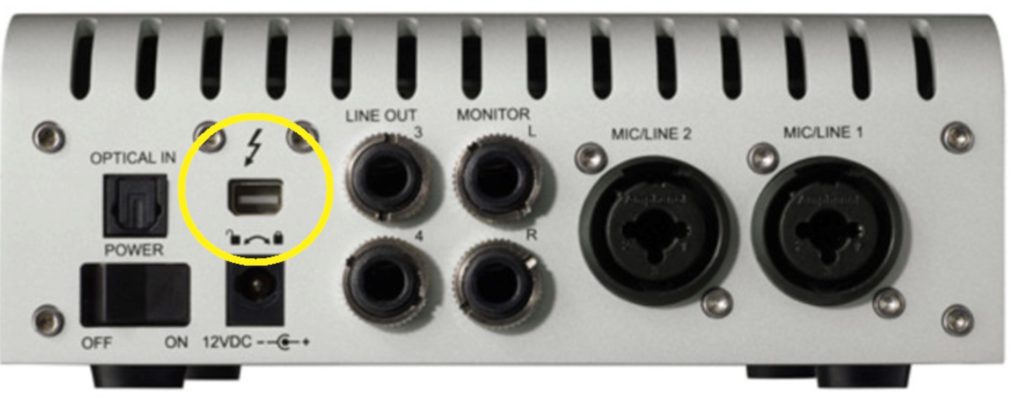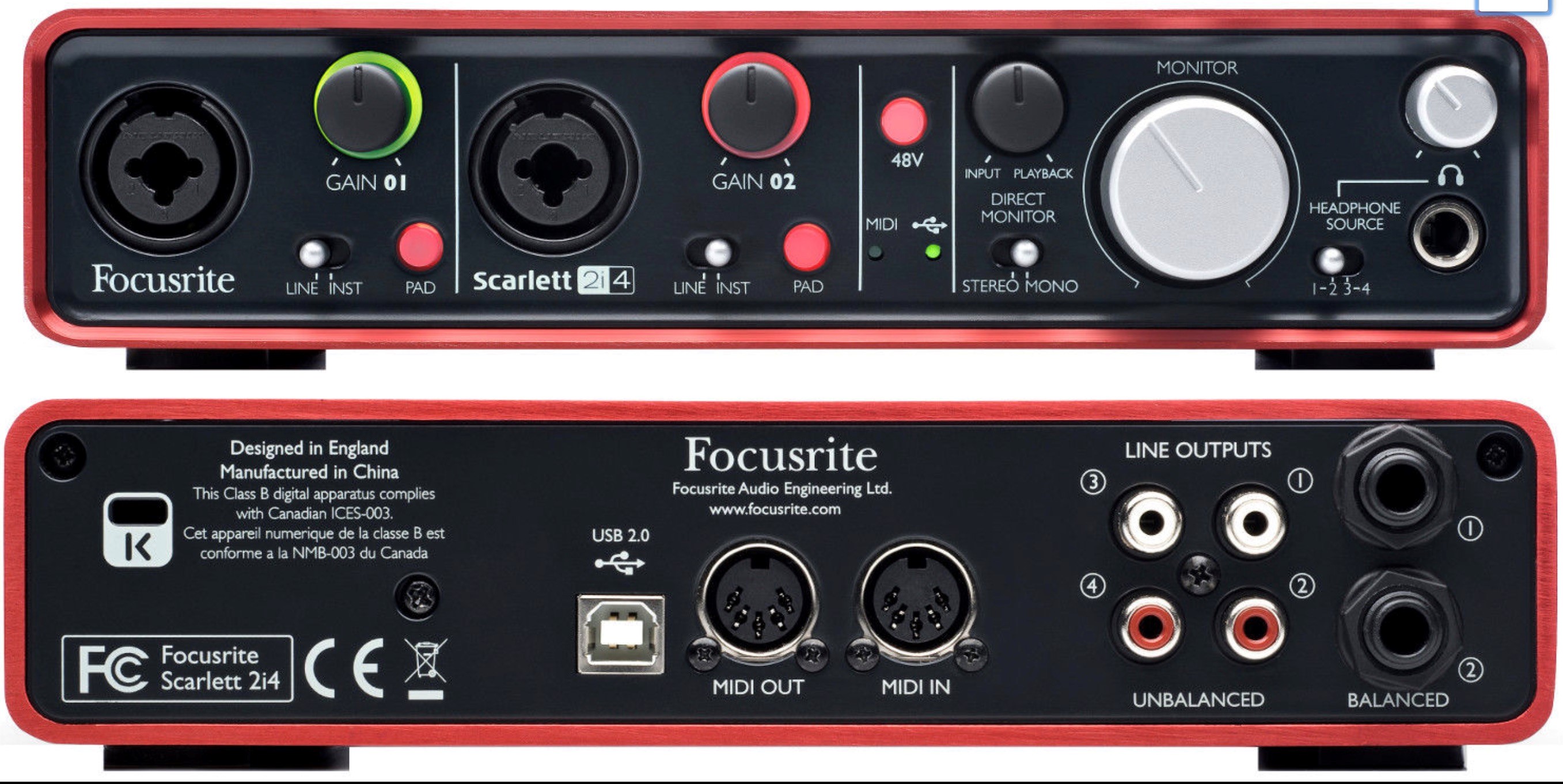
Interfaz de Sonido
Es muy importante conocer más a fondo los diferentes componentes y equipo que necesitarás para montar tu home studio, y para ello nos adentramos en el mundo de las interfaces de audio.
Qué es una interfaz de sonido?
En primer lugar, vamos a aclarar qué son las interfaces de audio. Antes de meternos a fondo, una aclaración: es probable que hayas escuchado hablar de interfaz de audio, interfaz de sonido, tarjeta de sonido etc. ¡No te preocupes, es lo mismo! Tan solo son diferentes formas de llamarlas, pero el nombre más técnico y más extendido es interfaz de audio.
Explicado de una forma sencilla, una interfaz de audio es el hardware que te permite trasladar los sonidos que quieras grabar a tu DAW (recuerda, la estación de audio digital, o en otras palabras, el software de producción musical). Es decir, la interfaz de audio es lo que te permite pasar el sonido acústico, la señal analógica (por ejemplo, la que produce cualquier voz o instrumento), a señal digital, que es lo que tu ordenador puede leer y procesar.
Por qué necesitas una interfaz de audio?
Esta es siempre la pregunta que todo el mundo se hace al plantearse comprar una interfaz de audio. El motivo es precisamente el que ya hemos visto. La mayoría de los estudios de grabación en la actualidad (y mucho más los home studio), centralizan la producción musical a través de la computadora. Con el avance de la tecnología, hay una tendencia cada vez mayor de abandonar los equipos analógicos para pasar a lo digital. Por lo tanto, todo lo que queramos grabar debe poder ser procesado por la computadora y por el software de producción. Piénsalo así: una computadora no entiende el sonido, así que para que puedas trabajarlo, es necesario pasarlo a un lenguaje que pueda comprender, y este lenguaje es la señal digital. No te preocupes, de momento no necesitamos profundizar mucho más sobre esto. A medida que avancemos, ya habrá tiempo de entrar en más detalle sobre los tipos de señales y otros conceptos más técnicos. Pues bien, la interfaz de audio es el equipo que capta esas señales analógicas que emite un instrumento y las convierte en señales digitales, capaces de ser tratadas por la computadora. Por ese motivo, una interfaz es algo de lo que no podemos prescindir en nuestro estudio. Si queremos hacer música en casa, necesitamos una interfaz de sonido.
Siguiente pregunta: Por qué tengo que comprarme una interfaz, si en mi computadora ya viene integrada una tarjeta de sonido? La respuesta es muy sencilla. Efectivamente, en tu computadora seguramente ya viene integrada una tarjeta de sonido. El problema es que las tarjetas de sonido que vienen incorporadas en las computadoras comunes no están preparadas para realizar ese tipo de procesamiento de sonido, que requiere mucha potencia y muchos recursos. Piensa que no estás montando un estudio de grabación para reproducir un par de canciones en Spotify. Lo que queremos es hacer nuestra propia música, y para ello no es suficiente el equipamiento común, sino que necesitaremos componentes de buena calidad que estén preparados específicamente para el tratamiento de audio.
En qué fijarte para comprar una interfaz de audio
Ya sabemos qué son las interfaces y por qué necesitamos una en nuestro estudio. Ahora la pregunta es: ¿cuáles son sus principales características? ¿En que debo fijarme para comprarme una? ¿Cuál es la que mejor se adapta a mis necesidades?
No te dejes engañar. Todas las interfaces de audio tienen básicamente las mismas características y funcionan de la misma manera. Son estas:
Entradas y Salidas
Por una parte, debemos tener muy en cuenta el número de entradas y salidas de nuestra interfaz. Es fundamental que te preguntes lo siguiente: ¿Para qué la quiero? ¿Qué uso le voy a dar?
La regla es que necesitarás tantas entradas como líneas quieras grabar simultáneamente. Eso dependerá en gran medida de la forma en la que grabes.
Básicamente existen dos métodos principales de grabación:
- Grabación por pistas: Hoy en día, hay mucha gente que graba por pistas, es decir, grabas primero una pista (ej. batería), luego sobre esa pista grabas la siguiente (ej. el bajo) y así sucesivamente hasta completar el tema. También podría llamarse grabación por capas. La técnica consiste en ir sumando capas hasta tener el resultado definitivo. Por lo tanto, si grabas por pistas (que es lo más habitual en un entorno de home studio), te será suficiente con tener una interfaz de audio con pocas entradas.
- Grabación en Vivo: a diferencia de la grabación por pistas, para grabar en vivo necesitarás tantas entradas como líneas de sonido se estén tocando a la vez. Por ejemplo, si quieres grabar a un grupo de 4 personas simultáneamente tocando en vivo, necesitarás tantas entradas como sonidos quieras grabar: varias entradas para las voces y otras muchas para los instrumentos. Ten en cuenta que hay instrumentos, como la batería, que necesitan varios micrófonos para captar los diferentes componentes (bombo, tarola, platillos, etc.).
Mi consejo, sobre todo si estás empezando, es que grabes por pistas. Es una forma más sencilla de iniciarse en la producción musical y de conocer cómo funcionan los flujos de sonido. También es una técnica increíble para potenciar la creatividad mientras compones. Además, necesitarás menos entradas, ¡por lo que podrás ahorrar mucho dinero y espacio!
El siguiente punto que hay que valorar es el tipo de entrada o salida. No todas las líneas necesitan del mismo tipo de entrada. En términos generales, existen dos tipos de entradas:
- Entrada de línea: este tipo de entradas sirven para conectar instrumentos como bajos y guitarras eléctricas.
- Entrada de micrófono: como su propio nombre indica, sirve para conectar micrófonos. Sin embargo, debemos tener en cuenta que los micrófonos de condensador requieren una potencia diferente para funcionar (48v). La mayoría de las interfaces de audio ya llevan incorporados un botón para activar los 48v de potencia para cuando quieras conectar tu micro de condensador, pero te recomiendo que te asegures bien antes de comprarla.
Las interfaces incorporan entradas híbridas, que gracias a su diseño permiten conectar tanto instrumentos como micrófonos.
Otro factor por tener muy en cuenta son las salidas de audífono. Hoy en día prácticamente todas las interfaces de sonido incorporan una salida de audífono. Es una característica fundamental para poder intercambiar de una forma sencilla entre escuchar tus producciones a través de los monitores y de los auriculares. Un consejo: si puedes, adquiere una interfaz que tenga más de una salida de audífonos. Te aseguro que te será muy útil cuando estés grabando a otra persona, ya que de esa forma los dos podrán escuchar cómodamente mientras graban.
- Preamplificadores
Los preamplificadores son probablemente el elemento más importante de las interfaces de sonido, ya que determinan la calidad de tus grabaciones. El objetivo es buscar una interfaz que lleve integrados unos buenos preamplificadores, fiables y, sobre todo, que transmitan un sonido claro y limpio. En la actualidad, la gran mayoría de las interfaces del mercado incorporan unos preamplificadores de una calidad suficiente.
- Conexión
Existen tres tipos de conexiones:
- USB: es la más usada actualmente, sobre todo en las interfaces de calidad media. Aunque no es la conexión más rápida de las existentes, es muy buena opción para home studios, sobre todo por su fácil conexión a las computadoras (todas las computadoras del mercado tienen forma de conectarse a los puertos USB). Además, con el USB 2.0 y USB 3.0, la velocidad ha aumentado considerablemente, haciendo que la conexión USB sea la preferida tanto por fabricantes como por usuarios.
- Firewire: Antiguamente las conexiones firewire solían ser más rápidas que las USB, pero hoy en día, la conexión USB no tiene nada que envidiarle a la firewire, consiguiendo proporcionar muy buena velocidad.
- Thunderbolt: es la conexión más rápida del mercado, ahora más frecuente en las computadoras actuales. Normalmente solo las interfaces de audio de mayor calidad (y, por lo tanto, mayor precio) incorporan conexión thunderbolt.
- Precio
Como siempre, es importante tener en cuenta el precio de los diferentes modelos. En Tu Home Studio, el objetivo es aprender a producir música y montar tu propio estudio de grabación con el presupuesto más ajustado posible.
Actualmente hay interfaces de audio para todos los presupuestos. Claro que, también hay opciones mucho más caras, que normalmente ofrecen más entradas y salidas y unos preamplificadores de la mejor calidad.
Conclusiones
En mi opinión, la mejor opción cuando adquieras una interfaz es que se ajuste a tus necesidades ya sea utilizando USB o Thunderbolt. Hablando de las conexiones con USB, la velocidad es más que suficiente y ha mejorado mucho con el USB 2.0 y 3.0. En cuanto al número de entradas, mi recomendación es que empieces con una interfaz de mínimo 2 entradas, con la que podrás grabar cómodamente por pistas e incluso grabar algunas interpretaciones en vivo.
Aunque siempre es recomendable tener más de una entrada. Lo mejor es que tengas una interfaz de 2 a 8 entradas, una para micrófono y otra para línea. Además de cuidar la calidad de los preamplificadores ya que algunas interfaces no son de tanta calidad y no ofrecen un sonido tan limpio.
 Carolina Antón es especialista en diseño y optimización de sonido, así como ingeniera de sonido independiente. Ha trabajado con varias compañías de sonido como la producción de 2hands, Eighth Day Sound, Britannia Row, Meridian Pro audio y Ocesa. Ha realizado giras por los EE. UU., México y América Latina con Zoe, Cafe Tacvba, Natalia Lafourcade, HaAsh. Carolina también es propietaria de Hibiki Production que proporciona servicios para grabación y transmisión en vivo.
Carolina Antón es especialista en diseño y optimización de sonido, así como ingeniera de sonido independiente. Ha trabajado con varias compañías de sonido como la producción de 2hands, Eighth Day Sound, Britannia Row, Meridian Pro audio y Ocesa. Ha realizado giras por los EE. UU., México y América Latina con Zoe, Cafe Tacvba, Natalia Lafourcade, HaAsh. Carolina también es propietaria de Hibiki Production que proporciona servicios para grabación y transmisión en vivo.





